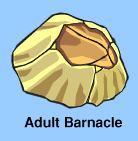|
|
Suspension Feeders
Plankton is a broad grouping of all the animals and plants which drift around in the ocean currents, independent of their size. The animals and plants range from microscopic one-celled organisms to giant jellyfish.
Plankton includes tiny green plants called diatoms, They have a beautifully patterned shell made of silica. Plankton also includes creatures that spend all their lives drifting around, including the juvenile stages of many shore creatures such as crustaceans, molluscs, echinoderms, worms and ascidians.
There are absolutely millions of billions of them. Every cup of surface seawater teems with plankton. There are probably hundreds of plankton in every drop of water.
Some of the countless single-celled plankton animals are the Dinoflagelates, Formanifera and Radiolarians.
- Dinoflagelates have chlorophyl, so can create their own energy but they also have animal characteristics.
- Formanifera are tiny floating cells that live their entire life in the ocean. They have a shell of lime.
- Radiolarians are single-celled animals with a shell of silica. In some parts of the ocean there are deep deposits of radiolarian ooze, created when dead radiolarians drift down from the surface.
It is the plankton food engine that drives much of the food-web ecology for a tremendous range of other creatures in the sea and on the shore.
 On
a rocky shore there are many plankton feeders, including all of the barnacles,
many species of worms such as Galeolaria, oysters, sponges, mussels, pipi,
cunjevoi, etc. They are all known as filter feeders because they have
adaptations such as specialised mouthparts, brush-like combs, or secrete
a slime from their gills to capture plankton food. As see Sponge
feeding.
On
a rocky shore there are many plankton feeders, including all of the barnacles,
many species of worms such as Galeolaria, oysters, sponges, mussels, pipi,
cunjevoi, etc. They are all known as filter feeders because they have
adaptations such as specialised mouthparts, brush-like combs, or secrete
a slime from their gills to capture plankton food. As see Sponge
feeding.
Bivalves and some other molluscs use their gills to obtain oxygen and their food as well as release carbon dioxide. They feed by drawing in the current of water and sifting the plankton and nutritive particles out using a mucous coating on their enlarged ciliated gills.
The entire fishing industry is almost totally dependent upon the fact that most species of commercial fish eat plankton during one or more stages of their life cycle.
Other not quite so friendly plankton are the harmful "bluebottle" jellyfish, and the potentially deadly box jellyfish.
Nutrient
Absorbers
Grazers & Browsers
Suspension Feeders
Deposit Feeders
Carnivores
Omnivores
Trophic Levels
Energy Pyramid
Home
Page
Taxonomy
Biogeography
Rocky Shores
Tidal Levels
Intertidal Zonation
Environmental Factors
Biological
Factors
Feeding Relationships
Activities
Glossary
References
 Life
on Australian Seashores
Life
on Australian Seashores
by Keith Davey (C) 2000
Learning Consultant
- Media
The University of Newcastle
email at australian_seashores@hotmail.com
Scientific Consultant: Phil
Colman
site created 01.01.98 : updated 01.04.2000
